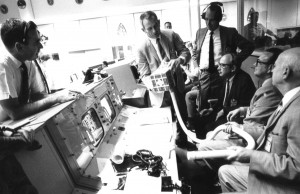 Deming famously stated “I should estimate that in my experience most troubles and most possibilities for improvement add up to the proportions something like this: 94% belongs to the system (responsibility of management), 6% special.“. In other words people-related ‘fault’ will be part of the minority 6%.
Deming famously stated “I should estimate that in my experience most troubles and most possibilities for improvement add up to the proportions something like this: 94% belongs to the system (responsibility of management), 6% special.“. In other words people-related ‘fault’ will be part of the minority 6%.
This statement tends to set people into a degree of hand-wringing ifs and buts: ‘surely he meant this only in a manufacturing system’, ‘ what about the difficult people?’, ‘ what if they are incompetent?’, ‘I am sure folks are the problem 40% of the time’ etc…
Chip and Dan Heath share a trivial, but insightful example in their book ‘Switch’. They discuss a situation (part of a research exercise) where moviegoers eat significantly more popcorn if they are given large buckets, than if they are given small buckets. To the outsider it looks like the people are ‘Popcorn Gorging Gluttons’ and we may feel that we should judge them as so. In reality, their behaviour (eating excessive amounts of popcorn) is driven by the system – the size of bucket they have been given. Change the bucket for a small one and their behaviour changes – they seem like moderate consumers. The system is the problem (large buckets), not the people.
“But aha – surely it’s their fault that they choose to scoff down the popcorn!”. True, we are sentient beings and can make choices (for example, I would hope that people who are aware of supermarket sales floor design are less likely to buy excessive amounts of fresh baked goods, fresh fruit and ‘buy-one-get-one-free’ items). I am not suggesting that we should excuse everyone of their behaviour 95% of the time. There are other things to consider – for example do we run on autopilot too often (Do we let the chimp drive the car? More for a later blog I think…)?
However as a start we need to be honest enough to examine our own assumptions as placed upon others and how we judge their behaviour. As the Heath brothers suggest, to do this we need to encounter a deep-rooted phenomenon identified in psychology.
Kendra Cherry explains -“When it comes to other people, we tend to attribute causes to internal factors such as personality characteristics and ignore or minimize external variables. This phenomenon tends to be very widespread, particularly among individualistic cultures.“
In Psychology this is known as the fundamental attribution error – we automatically assume that the person’s internal characteristics are the cause of behaviour even when other possible influencing factors are present in the situation.
So let’s pull away from assumption and open our minds to what is really happening with people.
Further Reading:
Deming W.E. (1982) Out of the Crisis (p315), MIT CAES, Cambridge MA.
Heath C., and Heath, D. (2010) Switch: when change is hard, New York: Random House
Peters S. (2012) The Chimp Paradox: The Mind Management Programme to Help You Achieve Success, Confidence and Happiness. Vermillion, London.
Other links:
Cherry, K. (2014) Attribution: How we explain behaviour. http://psychology.about.com/od/socialpsychology/a/attribution.htm
 Human beings have an innate sense of when people are not quite right. This is played with by fraudsters and con-men, but most of us can sniff a ‘bad-un’. This is an evolved capability, reading verbal and non-verbal signals. It is also based upon our previous expereinces of people (either a specific individual or groups of simialr types fo people). This can be conscious or unconscuious. We can make decisions obliquely and irrationally (Jacobs 2009; Peters, 2012).
Human beings have an innate sense of when people are not quite right. This is played with by fraudsters and con-men, but most of us can sniff a ‘bad-un’. This is an evolved capability, reading verbal and non-verbal signals. It is also based upon our previous expereinces of people (either a specific individual or groups of simialr types fo people). This can be conscious or unconscuious. We can make decisions obliquely and irrationally (Jacobs 2009; Peters, 2012).


